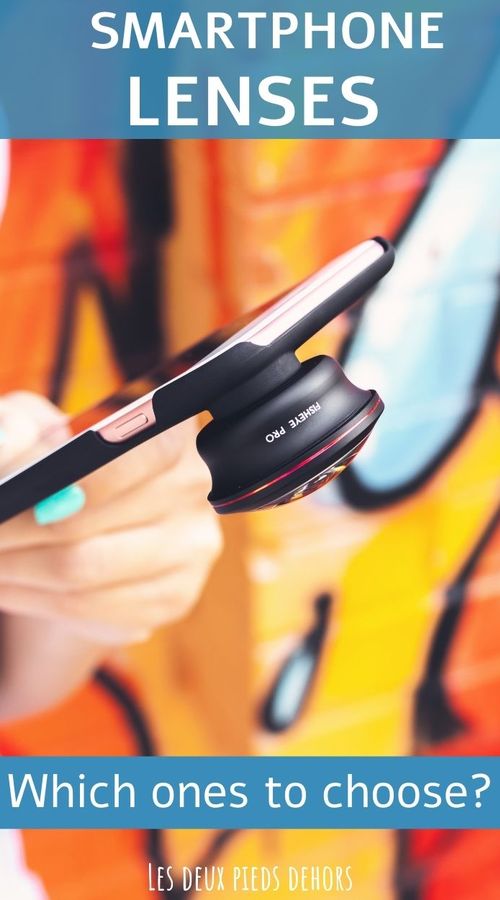Mobile camera lens: how to choose it and which one?
Last update: 04/19/2024
Our blog continues to grow thanks to you, our readers. This post may contain affiliate links, which means we can earn a small commission if you make a purchase through them, at no extra cost to you. This helps us to continue to bring you more and support our work!
How to go further with your smartphone in photography? It’s quite simple: just add a lens. Nowadays, you don’t need to be a great photographer to take beautiful pictures. I’ve experienced it for you! So, I said goodbye to my sophisticated camera, and here I go, taking pictures with my phone. Who’d have thought? Anything can happen! In this article, I’ll give you some explanations to understand mobile camera lenses and to know how to choose one. I reassure you right away, we are talking here about what I consider being “gadgets”, but which can clearly be useful for people who want to have fun taking better pictures with their phone!
1. Why do we use mobile lenses? What’s the point?
The mobile phone has turned many fields upside down and keeps doing it, and photography is no exception to the rule! Today, everyone owns a smartphone, and not only to make a phone call. Most users use it as a camera: landscapes, selfies, romantic dinners, evenings with friends, etc. Any excuse is good to immortalize a moment with your phone. Manufacturers have therefore logically provided accessories for taking pictures with your smartphone. But let’s be honest: although the image quality tends to improve with the new cell phone models, the result is not always great, depending on what you want to shoot. That’s where smartphone lenses come in (to a certain extent) …
But what is a mobile camera lens? It is an accessory allowing you to change the focal length of the classic lens of your phone. In other words: it allows you to take pictures of objects closer or farther than what you can conventionally do with your phone. Lenses for mobiles were originally designed for macro photography, given the poor quality of the image that becomes very pixelated when you zoom in with a smartphone. But telephoto lenses and other types of lenses have also flood the mobile market.
The interests of lenses for mobile are multiple:
- simplicity of use: you are not a professional photographer? It doesn’t matter, as these accessories are very easy to use and install! Clamped or not, you will be able to fix it on your phone in no time at all and enjoy it in the following seconds;
- easy to take everywhere: you don’t want to bother with photography equipment? Don’t worry about it: they’re light, small and take up very little space. You can easily slip them into a pocket of your hiking bag and walk around without any extra weight on your back;
- robustness: for having tested them in many situations, I can assure you that smartphone accessories are not fragile. They do not fear shocks or scratches, as far as it’s reasonable of course! Their metal structure ensures them a robustness out of the ordinary. They will therefore be your best adventures partners;
- practical: it is the least we ask of them, and they do fulfill their mission well! Most often sold in kit form, you will be able to take macro, wide-angle, fisheye or optical zoom photos, depending on what you want to shoot and the expected result;
- compatibility: it is also one of the great qualities of lenses for cell phones. Whether you have an iPhone, a Samsung, or other, you can adapt any lenses on it.

2. How to choose your lenses? Which criteria should be taken into account?
What are you going to shoot?
This question is crucial. Indeed, you are not going to use the same lens if you want to photograph the details of the moss in the forest or if you want to immortalize your visit in New York. To each photo its type of lens! And for that, it is imperative to know all the characteristics of each one of your lenses. I’ll detail them below. You will know everything about lenses (well, almost!) and you will have no more excuses if you fail to take great photos!
Characteristics of the lenses: weight, size, accessories, brands, etc.
As I told you before, a mobile lens is relatively light. It can vary depending on the brand and the type of lens. Its weight is around 30g, which is about the same as your phone. I do have a preference for light but high-performance lenses (I’ll talk about my top 5 later on). Anyway, they are all easy to handle.
Sizes also vary from brand to brand. Just like the weight, I think the first criterion to take into account is above all the quality of your future lens.
Many accessories are available when lenses are sold as a kit: clips, carrying case, cleaning cloth, etc. (here again, I’ll tell you about them below!). This can be a significant criterion in the selection of your future purchase (even if clearly, you won’t break the bank).
A quick word about brands: there are now dozens of manufacturers of lenses and telephoto lenses for mobiles. A few of them share the largest share of the phone accessory market. In my opinion, here are the most interesting brands in terms of price-quality ratio of their products: Pixter, Aftung, Merisny, Luxsure, Mpow,…
Choose your focal length: wide angle, macro, zoom or fish-eye
Here we are at the “technical part” – and I would say perhaps the most important one to prevent you from making mistakes in buying and using your lenses.
You will find 4 main families of lenses for mobile:
- wide angle: you want to take a picture of a beautiful landscape in French Polynesia, but you find your viewing angle not wide enough on your phone? If so, a wide-angle lens is the right one for you. It allows you to widen the angle of view while keeping the proportions of your photo and a maximum element on the image. The result is globally realistic, even if, depending on the lens, lines and shapes may be distorted (distortion phenomenon). This tool will also be very useful in places where you can’t step back, for example if you want to shoot a building located in a narrow street, in a concert, in a museum, etc…;
- macro: it is the essential accessory for nature lovers, and everyone wishing to immortalize the small elements that make it up. Have you ever observed objects with a magnifying glass? Well, a macro lens works in pretty much the same way. Be careful, you will have to place your camera very close to the object you want to shoot in order to obtain an optimal result (as the focusing distance is reduced with this type of lens);
- the telephoto/zoom lens: although cell phone zooms are more and more sophisticated, the rendering of certain distant details is sometimes of very poor quality, since they can be blurred. A telephoto lens for mobiles will allow you to keep the best definition of your mobile. It is ideal for taking beautiful pictures of distant elements;
- the fish-eye: if you want original and artistic photos with style effects, then you need a fisheye lens! It has a very short focal length, with an ultra-wide angle of view. The elements on the pictures are very numerous and the edges are distorted. This gives the impression of a spherical image: everything close is exaggeratedly large, and everything far is small.


Buy a separate lens or a kit?
I would say that it depends a bit on the accessories you already have in your possession, and especially on the type of shots you want to take. It comes back to the question: what are you going to shoot? If you’re a wildlife photography enthusiast and swear by safaris, then a telephoto lens for a smartphone will be useful, but not necessarily a macro lens… So, before buying your lenses, I advise you to think carefully about the use you’re going to make of them. Kits are generally composed of 3 or 4 lenses, and usually have a pocket or a carrying case. If you are new to photography with your cell phone, there are also packs containing additional accessories such as a mini tripod, a remote control (which allows you to control your smartphone remotely), a selfie stick, etc. The advantage of these kits is that you can fully equip yourself and try out all the accessories that could be useful to you. For those you won’t necessarily use today, just keep them: you never know, they may be useful some day. At least, you will already have them on hand!
3. Which camera lens for mobile to choose, then? Our TOP 5
After describing the features and benefits of the different mobile lenses, here are my 5 favorites.
1 - The LUXSURE smartphone lens: basic but effective
It may not be universally acclaimed by experienced photographers, but it still makes great photos to share on your social networks. Composed of a 0.6X wide angle and a 15X macro, this duo adapts to the majority of phone models (iPhone, Samsung, Huawei, etc.) thanks to its two lens clips. Its original design reminding of a rose and its package including 4 lens covers, a cleaning cloth, a pouch and a box, make the LUXSURE smartphone lens a perfect gift!
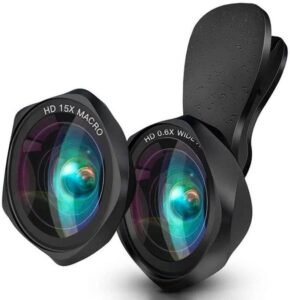
2 - The 9 in 1 Aftung mobile lens kit: ideal for beginners
You’re not a professional photographer, and even less so with your phone? Then, I recommend this kit. It will allow you to equip yourself with all the accessories you need to take your first steps in photography. Its price is correct and, thanks to the range of accessories, you will be able to practice on many types of shots. It comes with a compact carrying case and includes:
- Two macro lenses: 15X and 20X
- Two wide-angle lenses: 0.36X and 0.63X
- A Fisheye lens at 198°.
Little extras you won’t find in every lens kit such as:
- the Starlight lens: nothing else than a filter. We all know the magic power of filters: no more risk of failed photos, all your shots will be successful!
- the kaleidoscope lens: you’ll have an original look, to say the least, with your central element being photographed with 6 sub-lenses.
Two fixing clips and a cleaning cloth complete the set. You will be able to indulge in the pleasures of photography with your smartphone like a pro!

3 - Kit 3 in 1 Mpow smartphone lenses: the right value for money
If you want to invest in quality lenses for smartphones without breaking the bank, I recommend this pack of 3 lenses:
- A 10X macro lens;
- A wide-angle lens 0.65X;
- A fish-eye lens offering a 180° vision.
These lenses are compatible with most phones (Samsung, Sony, iPhone, Wiko, Huawei, etc.). This kit is also equipped with a mounting clip, two lens caps and a protective case.
In short: basic equipment, but easy to use for beautiful photos, all at a very affordable price! What more could you ask?
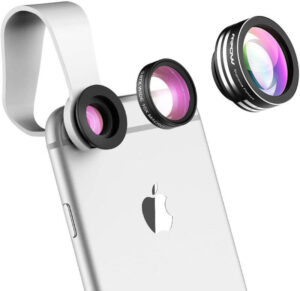
4 - Merisny's 10 in 1 kit: the most complete one
For the most ambitious or perfectionist ones, the Merisny 10 in 1 mobile lens kit is the one you need. In order to make the ideal photo, you’ll have the choice between 10 lenses, including 2 macros (15X and 20X), 2 Super Wide Lens (wide angle of 0.63X and 0.36X), 1 Fisheye 198°, 1 kaleidoscope, 1 CPL (polarizing filter to sublimate colors), 1 star filter (Starburst Lens), 1 flux filter (suitable for moving objects), and 1 2X telephoto lens.
This really-complete pack also includes 2 clips as well as a storage case.
Its wide choice of lenses will allow you to take all kind of photos: from portraits to grandiose landscapes, including wildlife and flora. You’ll be able to capture everything, with a rendering worthy of a professional photographer (or almost, haha)!
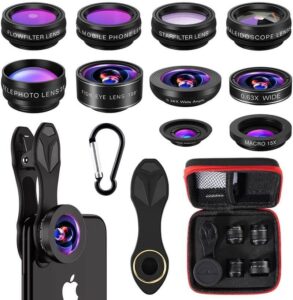
5 - Pixter's lenses for smartphone Pro: the most popular manufacturer in France
I couldn’t go without mentioning a French manufacturer in my top 5, as the article was first written in French. Because a bit of patriotism doesn’t hurt, and the optical quality makes it worthy being in this top… In the Pro range, you will have the choice between:
- the telephoto Pro: with a focal length of 60 mm and a 2X magnification, this telephoto lens for smartphone can be useful to take pictures of distant elements, while keeping the sharpness of the image;
- the Pro macro lens: 4.5X without any blur or distortion. It is ideal for photographing flowers, insects and all microscopic elements of fauna and flora;
- the Pro wide-angle lens: equivalent to an 18mm lens and captures 2X the width of field. It will allow you to take very wide shots and is very practical when you don’t have enough distance;
- the Super Fisheye Pro : with an ultra-wide angle of 235° and a focal length of 11.2 mm, it’s the GoPro effect guaranteed! For fans of this type of lens, it’s top of the line.
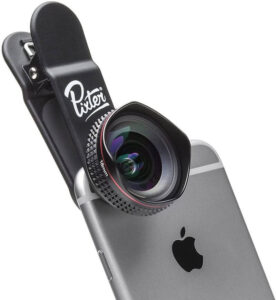
Note that all these lenses for mobile are light (between 29 and 36 g) and still very robust, thanks to their metal structure.
Choosing a mobile lens has no more secrets for you now! So, don’t wait any longer: to take your best pictures with your smartphone, invest in macro, wide-angle, fish-eye, telephoto and other lenses. And for the purists who don’t want to take pictures with their smartphone, and neither want to be laden with a too heavy camera, you should have a look at compact cameras. By the way, I wrote a complete article on the subject!
Well, I reassure the curious ones who would have come by to read this little article: I’m not going to start taking pictures with my smartphone every day. I love my Canon 6D and there’s no way I’m giving up my DSLR for a phone, haha. Plus, I just bought a small second-hand lens, an 85mm f/1.8, perfect for taking pictures of my kids!
See you soon,

Written by Sylvain PONS
I've been passionate about photography since 2010, learning as I went along. Today, I dedicate myself to guiding others in their choice of camera gear and sharing a variety of tips to improve their photography skills.
Despite our care, a mistake may have slipped into this article. If you find any, please don't hesitate to let us know so we can correct it as soon as possible and keep our information up-to-date!


